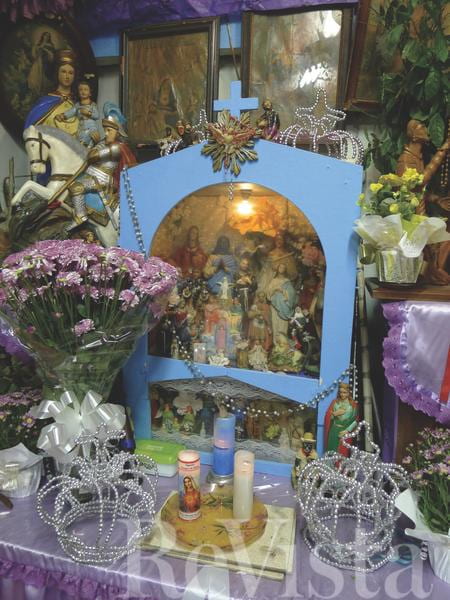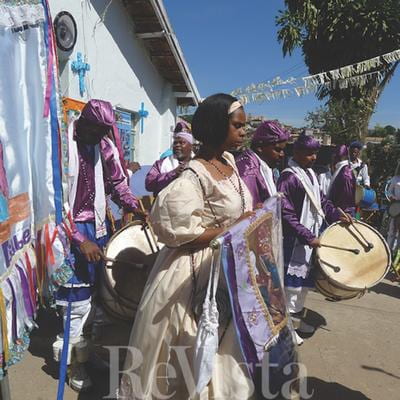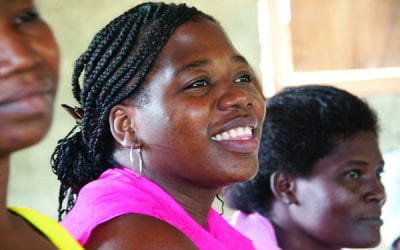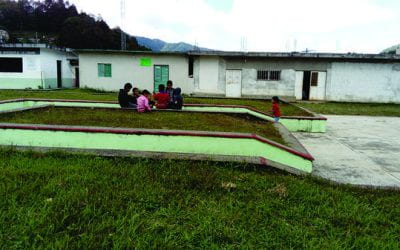Multi-Faith Lives of Brazilian Congadeiros and Umbandistas
Dissertation Advice from an Old Black Slave Spirit
I stood outside of the small chapel, pointing my video camera through the grates of the window. Inside, the devotees of the religious group Moçambique Thirteenth of May of Our Lady of the Rosary drummed and sang to beseech divine protection from Our Lady of the Rosary and black saints. The enchantment that they wove with their singing constituted the ceremonial preparations for a festival of Congado, a syncretic Afro-Brazilian ritual of popular Catholicism. While the camera captured the sounds that emanated from the chapel, I briefly turned my gaze toward the adjacent hills, observing the urban patchwork of precariously built, low-income housing so characteristic of Belo Horizonte, the capital of Minas Gerais, and other megacities of Brazil.
Dona Isabel Cassimiro das Dores Gasparino, the group’s leader and Congado queen—a royal title used to indicate hierarchy among these musicians (Congadeiros) since at least the 17th century in Brazil—had granted me permission to film the ritual preparations in the chapel as part of my dissertation fieldwork. Worried that my recording might interrupt the ceremony, I tried to make my ethnographic presence, despite a hardly surreptitious video camera, camera, and notebook, as incognito as possible. Yet soon after I started to document the ritual, senior member of the group Sebastião Corrêa Braga led me into the chapel, motioning for me to stand on a couch by the back wall. Despite my concerns about alighting upon the furniture, I quickly realized the new vantage point provided a fine sight line for filming.
The Congadeiros began the morning rituals that August day in 2014 with a particular song that requested intercession from Our Lady of the Rosary to prepare their minds and bodies for the spiritual forces that they would encounter throughout the festival. Using the rhythmic pattern known as serra abaixo, the drums (tambores) played a slow-tempo call-and-response exchange, while captain Ricardo Cassimiro das Dores Gasparino, a day laborer in his mid-forties and son of Dona Isabel, sang, “I ask for permission from my mother, the woman of the rosary.” The other Congadeiros answered verbatim, stretching each word across a simple melody as several members continued to drum. Ricardo Cassimiro then placed his hand in the water vessel on the altar and proceeded to wash the sacred batons, symbols of leadership and sacrality, with the water. The Congadeiros continued to play the drums, in addition to the patangome, a shaker whose swooshing sound derives from the movement of black seeds within welded automobile hubcaps, as they intermittently sang, “I ask for permission from my mother, the woman of the rosary.” Soon the song came to an end, signaling the devotees’ preparedness for the spiritual journey to begin.
The singing and drumming were directed toward the altar. To an outsider, the statues of Catholic saints, caboclos (indigenous Brazilians), pretos velhos (old black slaves), boiadeiros (cowboys), and marujos or marinheiros (sailors) that vied for space on the altar might look like an aesthetics of hodgepodge. But to devotees, the cascading layers of figures arranged on the altar signaled reconciliation between different sacred traditions originating from African diaspora religions and Roman Catholicism. It is not that worshipers of African-derived religions did not suffer erasure, oppression, and exploitation at the hands of Portuguese Catholic authorities, but that the encounter between different religious traditions compelled worshipers to be resourceful and reconciliatory in their forging of a New World tradition.
Soon after the Congado festival, Dona Isabel, both a Congado queen and a mãe-de-santo (mother-of-divinity) in Umbanda, invited me to a session at the chapel, a structure that functions dually as a place of popular Catholicism and Umbanda. In fact, while the chapel serves as a place of worship for popular Catholic rituals on the weekends, it is re-purposed in Umbanda sessões or giras (healing and consultation ceremonies) on Monday, Wednesday, and Friday evenings. The chapel, moreover, is referred to as the terreiro (temple) during Umbanda. Umbanda, a syncretic Brazilian religion focused on spirit possession, blends African diaspora religions with Roman Catholicism, Amerindian shamanism, and Spiritism, a spiritualistic philosophy begun by a French educator known as Allan Kardec who postulated that immortal spirits take on human form in various incarnations to achieve moral and intellectual edification. Umbandistas engage in spirit possession to call spirits from the astral plane into their bodies for healing and spiritual guidance. Although Umbanda did not coalesce as a de facto religion until the 1920s in Rio de Janeiro, it is generally accepted that devotees, from disenfranchised Afro-Brazilians to middle class non-black people, began practicing Umbanda in an inchoate form in Brazil as early as the 19th century.
Broadly speaking, Catholicism was not only the official religion of Brazil from the time the Portuguese colonized Brazil in 1500 until 1889 when the establishment of the republic rendered church and state formally separated, but the Portuguese also prohibited African and African diaspora religions in toto. Yet, Africans and Afro-descendant peoples (enslaved, free, and freed) creatively maneuvered around these proscriptions by associating Catholic saints with African deities. For example, Ogum, the deity of iron and war in Umbanda became synonymous with the Catholic symbol of Saint George. Hence, the ambiguity within which Catholic and Umbanda statues signify speak to the creative ways in which practitioners have made their religious cosmologies converge over the centuries. What is more, throughout my fieldwork, I came to understand that while Umbanda and Congado are embodied simultaneously, they are expressed serially. In other words, devotees carry out religiously pluralistic traditions, but implement individual rituals on different days of the week, in addition to attributing different meanings to them. Thus, while worshipers cognitively and corporeally embody distinct religions at the same time, rituals must be expressed in distinctly temporal and symbolic ways.
The following exchange with Antônio Cassimiro das Dores Gasparino, a security guard in his late forties and another of Dona Isabel’s sons, helped me to understand that while both religions coalesce to form a sacred totality in their lives, it is a collective whole that is separately articulated. We were talking in the chapel when I motioned toward the altar,
GD: There, on the altar, you have a statue of Saint George, which is also Ogum.
AG: You speak of Saint George and Ogum. This is what happens. Here we have both a house of Congado and a house of Umbanda. There is this mixture. There is this reality. But in Congado, we don’t say that Saint George is Ogum. We say Saint George. There is separation. When it is a festival of Umbanda, it isn’t Saint George, it’s Ogum. Each thing in its own place. There is separation. One doesn’t mix one thing with another.
GD: But, for example, why have a separation if a saint is the two things?
AG: But here is the question. When it is praise in honor of the rosary, it is praise in honor of the rosary. When it is something from Umbanda, it is Umbanda. It is not the same time. Coffee is coffee, milk is milk. Combine the two, it is café com leite. It is neither café nor milk, it is coffee with milk—café com leite. This is why there is a separation. (Antônio Cassimiro das Dores Gasparino 2014)
With a simple metaphor of coffee with milk, Antônio illuminated how Afro-Brazilian worshipers often lead religiously pluralistic lives, finding harmony in praising Catholic saints on one day of the week and worshiping African orixás (immortal deities) and incorporating spirits on another day. He explained how the individual religious components troped as coffee and milk must run separately for musico-religious pluralism to work. Each component works individually to fulfill the overarching goal of encouraging supernatural deities to intervene in their everyday lives. Indeed, they believe each to contribute uniquely toward building matrixes of social, economic and sacred support in the face of societal exclusion and affliction. Hence, religious boundary separation and crossing diversify and enrich devotees’ toolkit as they pursue self-empowerment, social justice, and healing in the material world.
In both Umbanda and Congado, practitioners see music as a mystical conduit that enables them to perform a kind of spiritual work that brings prosperity to the body and mind. Just as Congadeiros use sacred song and prayer to ask for blessings from Our Lady of the Rosary, these same practitioners during Umbanda sessions use songs (pontos), dance, and prayer to call spirits of caboclos (indigenous Brazilians), pretos velhos (old black slaves), crianças/erês (children), baianos (people from the state of Bahia), boiadeiros (cowboys), marujos or marinheiros (sailors), and exús and pombas-giras (male and female tricksters, respectively) from celestial heights to inhabit their bodies and instantiate healing and resolve problems. Initiates (filhos-de-santo, literally children-of-the saint) desire to be possessed by the spirits of these archetypal figures because in coming to serve as mediums (médiuns), they aid and counsel other devotees in fixing dilemmas and appeasing orixás.
The first time that I attended an Umbanda ceremony, I observed one devotee become possessed by a spirit. Suddenly, his body convulsed. Growing hunched, he hobbled about as if crippled by senility. He beckoned for someone to retrieve a cane that stood in the corner of the chapel. With labored movements, he made his way over to a small, white bench. Dona Isabel brought me to sit face-to-face with the possessed medium so that I might consult him on any matters of consternation. Broadly speaking, spirits in Umbanda serve less as oracular mediums who tell the future and more as counselors offering advice on personal obstacles. As I sat in front of him, his eyes remained closed. He only moved to puff on a pipe. And then, he spoke, breaking the profound silence between us. Despite being fluent in Portuguese, I could hardly understand a word.
Dona Isabel whispered to me that the medium embodied the preto velho Father Joaquim, so his Portuguese was that of pre-emancipation Brazil (1500-1888). She offered to stay and translate the language of the old slave spirit into modern Portuguese. During the transatlantic slave trade, close to six million Africans were forcibly brought to Brazil. Although the law of 7 November 1831 abolished the maritime slave trade and freed the Africans who were illegally imported to Brazil, the slave trade continued unabated both across the Middle Passage and within Brazil until Princess Isabel abolished slavery in Brazil by dictum in 1888. Slaves primarily came from vast expanses of the west coast of Africa, primarily being drawn from Bantu cultural areas of West Central Africa (present-day Angola, the Democratic Republic of the Congo, and Gabon) and the Yoruba, Ewe, and Fon cultural areas of West Africa (present-day Guinea, Nigeria, Togo, and Benin (Dahomey)). Given the diversity of peoples who were trafficked in the Luso-Brazilian slave trade, it is difficult to speak of a homogenous African population in Brazil. Nonetheless, one can speak of the many convergences that marked enslaved Africans’ experiences in Brazil: dispossession, hunger, and violence.
The encounter with Father Joaquim made me realize that this figure was not a wild extremity, but rather a purposeful archetype who embodied the history of a disenfranchised people whose resilience was as sacrosanct as their religious practices. Father Joaquim was one of many old black slave spirits who returned perpetually in human form to teach followers about the struggle, both past and present, against those who worked and continue to work to invalidate their humanity.
At the time that I conducted fieldwork, I was formulating a dissertation about the music of Afro-Brazilian communities who struggle for social justice via African-and European-derived sacred ritual in wider contexts of racism and exclusion. When it came to turning the participant-observation and interviews of fieldwork into a dissertation, the process proved daunting. So, I asked Father Joaquim, “How do I make sense of the fieldwork and then turn it into a dissertation?” Resolute, he answered, “Let the devotees speak.” This counsel became a guiding force in the dissertation writing process as I strove to intertwine my observations with worshipers’ performative voices.
Strikingly, what seemed prime facie like straightforward dissertation advice from Father Joaquim was really his clarion call for the decolonization of dissertation writing. Indeed, Father Joaquim’s advice favored the exercise of agency by devotees. In reflecting upon this, I realized just how much a dispossessed historical figure, representing in bodily form Brazil’s negation of Afro-Brazilians’ humanity and humanness during slavery, could still serve as a preeminent symbol of what it looks like to work toward negating the inequalities of Afro-Brazilians in the here and now. Hence, this old slave spirit, rather than being the antithesis of modernity, became the mobilizer of it.
My encounter with Father Joaquim informs my larger thinking about how practitioners see Congado and Umbanda as individual cogs that form a unified wheel rotating toward redemption. Although an agenda of racial empowerment is not always explicit in Congado and Umbanda as both black and white citizens participate, the communities whose congregations are predominantly Afro-Brazilian work toward socio-spiritual justice by making legible their performances as healing, black pride, and social commentary. In the end, the advice from Father Joaquim was not merely about solving an ephemeral, personal problem. For myself and others who are willing to listen, the guidance from an old black slave spirit was meant to render audible devotees’ present-day struggles to create lasting racial equality in a longstanding history of alterity.
Winter 2018, Volume XVII, Number 2
Genevieve E. V. Dempsey is the 2017-18 Mark Claster Mamolen Fellow at Harvard’s Hutchins Center for African and African American Research. An ethnomusicologist and musician, Dempsey specializes in the sacred musics of Brazil. Her ethnographic and archival fieldwork among communities that practice African-and European-derived syncretic traditions of Congado, Candomblé, and Umbanda articulate with broader interdisciplinary conversations about ritual, race, class, gender, and sexuality.
Related Articles
Afro-Latin Americans: Editor’s Letter
My dear friend and photographer Richard Cross (R.I.P.) introduced me to the unexpected world of San Basilio de Palenque in Colombia in 1977. He was then working closely with Colombian anthropologist Nina de Friedemann, and I’d been called upon by Sports Illustrated to…
Witches, Wives, Secretaries and Black Feminists
The issue of gender has been front and center for me, both as a subject of my fieldwork on black politics in Latin America, and how I conducted that research, particularly in how I…
Compañeros En Salud
English + Español
I have lived in non-indigenous rural Chiapas in southern Mexico since 2013, working with Compañeros En Salud (CES)—a Harvard af liated non-profit organization that partnered with…







